A Photon Imaging Detector Model with High Resolution and High Counting Rate
Abstract
1. Introduction
2. Detector Structure
3. Model Description
4. Simulation Results
4.1. Setting of Shaping Parameters
4.2. Point Spread Function
5. Conclusions
Author Contributions
Funding
Institutional Review Board Statement
Informed Consent Statement
Data Availability Statement
Conflicts of Interest
References
- Oelsner, A.; Schmidt, O.; Schicketanz, M. Microspectroscopy and imaging using a delay line detector in time-of-flight photoemission microscopy. Rev. Sci. Instrum. 2001, 72, 3968–3974. [Google Scholar] [CrossRef]
- Tremsin, A.S.; Siegmund, O.; Hull, J.S. High Resolution Photon Counting Detection System for Advanced Inelastic X-ray Scattering Studies. In Proceedings of the 2006 IEEE Nuclear Science Symposium Conference Record, San Diego, CA, USA, 29 October–4 November 2006; pp. 735–773. [Google Scholar]
- Shikhaliev, P.M.; Molloi, S. Count rate and dynamic range of an x-ray imaging system with mcp detector. Nucl. Instrum. Methods Phys. Res. A 2006, 557, 501–509. [Google Scholar] [CrossRef]
- Lees, J.E.; Pearson, J.F. A large area mcp detector for x-ray imaging. Nucl. Instrum. Methods Phys. Res. A 1997, 384, 410–424. [Google Scholar] [CrossRef]
- Zhang, X.; Chen, B. Wide-field auroral imager onboard the Fengyun satellite. Light. Sci. Appl. 2019, 45, 3957–3960. [Google Scholar] [CrossRef]
- Diebold, S.; Barnstedt, J.; Hermanutz, S. UV MCP Detectors for WSO-UV: Cross Strip Anode and Readout Electronics. IEEE Trans. Nucl. Sci. 2013, 60, 918–922. [Google Scholar] [CrossRef]
- Conti, L.; Barnstedt, J.; Buntrock, S.; Diebold, S.; Schaadt, D.M. Microchannel-Plate Detector Development for Ultraviolet Missions. In Proceedings of the SPIE Conference, Astronomical Telescopes and Instrumentation, Online, 14–18 December 2020. [Google Scholar]
- Conti, L.; Barnstedt, J.; Hanke, L.; Kalkuhl, C.; Kappelmann, N.; Rauch, T.; Stelzer, B.; Werner, K.; Elsener, H.-R.; Schaadt, D.M. MCP detector development for uv space missions. Astrophys. Space Sci. 2018, 363, 63. [Google Scholar] [CrossRef]
- Siegmund, O.; Vallerga, J.V.; Mcphate, J.B.; Tremsin, A.S. Next generation microchannel plate detector technologies for UV astronomy. Proc. SPIE Int. Soc. Opt. Eng. 2004, 5488, 789–800. [Google Scholar]
- Siegmund, O. High-performance microchannel plate detectors for UV/visible astronomy. Nucl. Inst. Methods Phys. Res. A 2004, 525, 12–16. [Google Scholar] [CrossRef]
- Tremsin, A.S.; Siegmund, O.; Vallerga, J.V.; Hull, J.S. Novel high resolution readout for uv and x-ray photon counting detectors with microchannel plates. Proc. SPIE–Int. Soc. Opt. Eng. 2006, 6276. [Google Scholar] [CrossRef]
- Tremsin, A.S.; Siegmund, O.; Vallerga, J.V.; Raffanti, R.; Weiss, S.; Michalet, X. High speed multichannel charge sensitive data acquisition system with self-triggered event timing. IEEE Trans. Nucl. Sci. 2009, 56, 1148–1152. [Google Scholar] [CrossRef]
- Jiang, Z.; Ni, Q. Design and Performance of Photon Imaging Detector Based on Cross-Strip Anode with Charge Induction. Appl. Sci. 2022, 12, 8471. [Google Scholar] [CrossRef]
- Seljak, A.; Cumming, H.S.; Varner, G.; Vallerga, J.; Raffanti, R.; Virta, V. A fast, low power and low noise charge sensitive amplifier asic for a uv imaging single photon detector. J. Instrum. 2017, 12, T04007. [Google Scholar] [CrossRef]
- Vallerga, J.; Mcphate, J.; Tremsin, A.; Siegmund, O.; Varner, G. Development of a flight qualified 100 × 100 mm MCP UV detector using advanced cross strip anodes and associated ASIC electronics. In SPIE Astronomical Telescopes + Instrumentation. Space Telescopes and Instrumentation 2016: Ultraviolet to Gamma Ray, Edinburgh, UK; SPIE: Bellingham, WS, USA, 2016. [Google Scholar]
- Pfeifer, M.; Diebold, S.; Barnstedt, J.; Hermanutz, S.; Kalkuhl, C.; Kappelmann, N. Low power readout electronics for a uv mcp detector with cross strip anode. J. Instrum. 2014, 9, 705–710. [Google Scholar] [CrossRef]
- Pfeifer, M.; Barnstedt, J.; Diebold, S.; Hermanutz, S.; Werner, K. Characterisation of low power readout electronics for a UV microchannel plate detector with cross-strip readout. SPIE Astron. Telesc. Instrum. 2016, 9144, 914438. [Google Scholar]
- Ni, Q. Optimization for spatial resolution and count rate of a far ultraviolet photon-counting imaging detector based on induced charge position-sensitive anode. Acta Opt. Sin. 2014, 34, 0804001. [Google Scholar]
- Siegmund, O.; Tremsin, A.S.; Vallerga, J.V. High Performance Cross-Strip Detector Technologies for Space Astrophysics; IEEE Nuclear Science Symposium Conference Record: Honolulu, HI, USA, 2007. [Google Scholar]
- Vallerga, J.; Raffanti, R.; Cooney, M.; Cumming, H.; Varner, G.; Seljak, A. Cross Strip Anode Readouts for Large Format, Photon Counting Microchannel Plate Detectors: Developing Flight Qualified Prototypes of the Detector and Electronics; International Society for Optics and Photonics: Montréal, QB, Canada, 2014; Volume 9144, pp. 1090–1101. [Google Scholar]
- Siegmund, O.; Mcphate, J.; Curtis, T.; Darling, N.; Ertley, C. Development of UV imaging detectors with atomic layer deposited microchannel plates and cross strip readouts. In X-ray, Optical, and Infrared Detectors for Astronomy IX; SPIE: Bellingham, WS, USA, 2020. [Google Scholar]
- Omote, K. Dead-time effects in photon counting distributions. Nucl. Instrum. Methods Phys. Res. B 1990, 293, 582–588. [Google Scholar] [CrossRef]
- Cretot-Richert, G.; Francoeur, M. Applications Expand for Photon Counting. Photonics Spectra 2014, 48, 43–46. [Google Scholar]
- Saito, M.; Saito, Y.; Mukai, T.; Asamura, K. Spatial charge cloud size of microchannel plates. Rev. Sci. Instrum. 2007, 78, 023302. [Google Scholar] [CrossRef]
- Ni, Q.; Song, K.; Liu, S. Curved focal plane extreme ultraviolet detector array for a EUV camera on CHANG E lander. Opt. Express 2015, 23, 30755–30766. [Google Scholar] [CrossRef]
- Jordanov, V.T.; Knoll, G.F.; Huber, A.C.; Pantazis, J.A. Digital techniques for real-time pulse shaping in radiation measurements. Nucl. Instrum. Methods Phys. Res. 1994, 353, 261–264. [Google Scholar] [CrossRef]
- Jordanov, V.T.; Knoll, G.F. Digital synthesis of pulse shapes in real time for high resolution radiation spectroscopy. Nucl. Instrum. Methods Phys. Res. 1994, 345, 337–345. [Google Scholar] [CrossRef]
- Tremsin, A.S.; Vallerga, J.V.; Siegmund, O.; Hull, J.S. Centroiding algorithms and spatial resolution of photon counting detectors with cross-strip anodes. Proc. SPIE Int. Soc. Opt. Eng. 2003, 5164, 113–124. [Google Scholar]
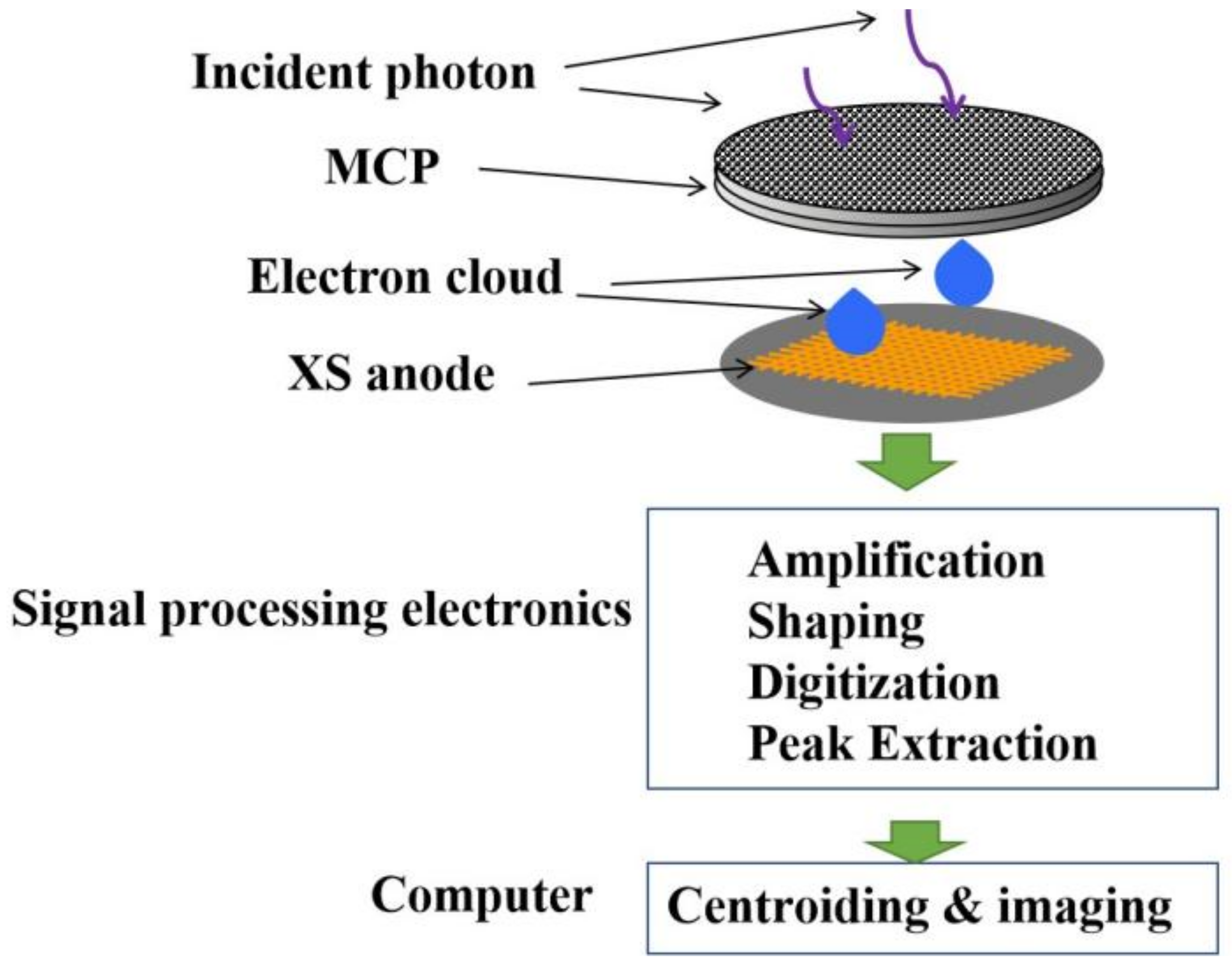
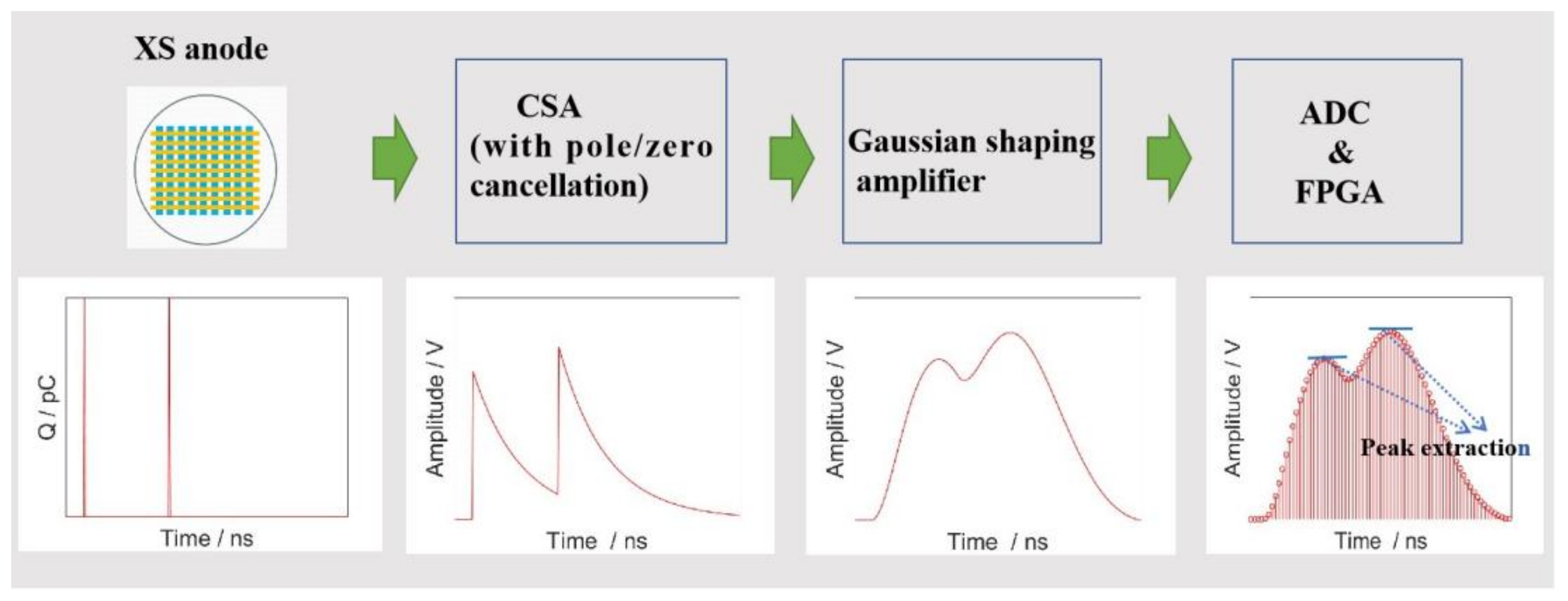
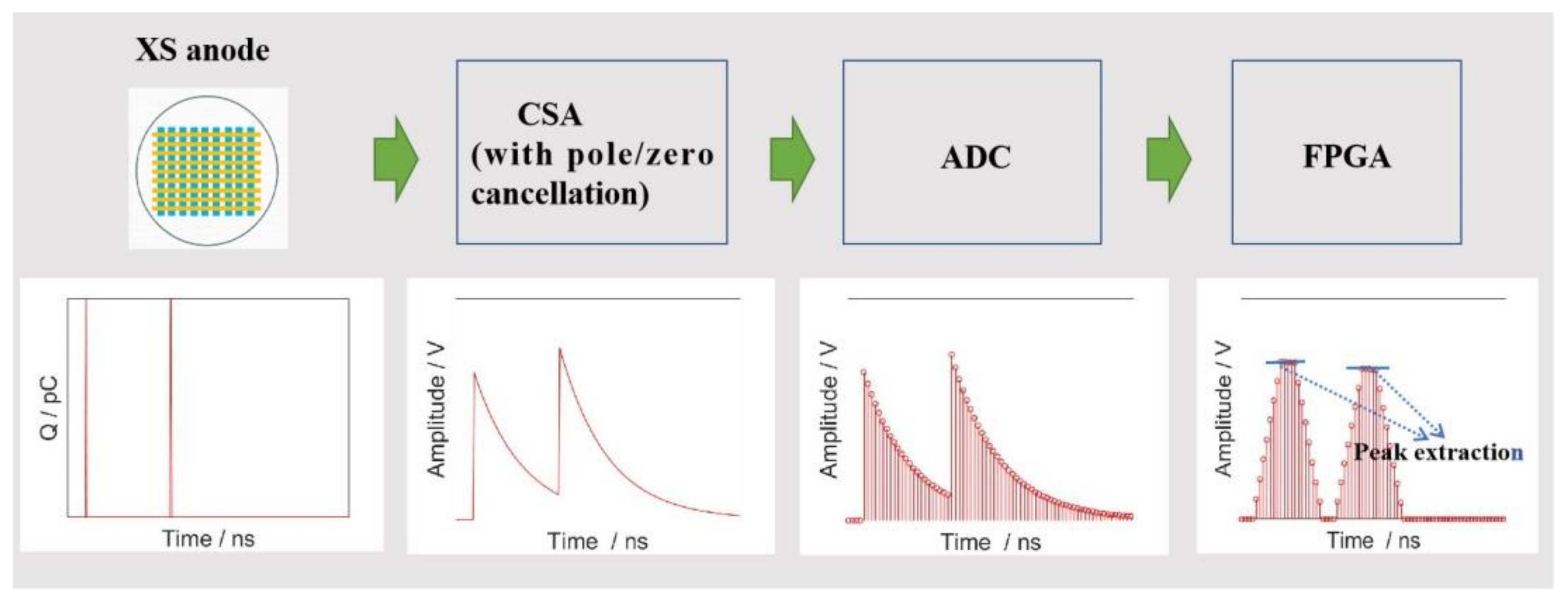

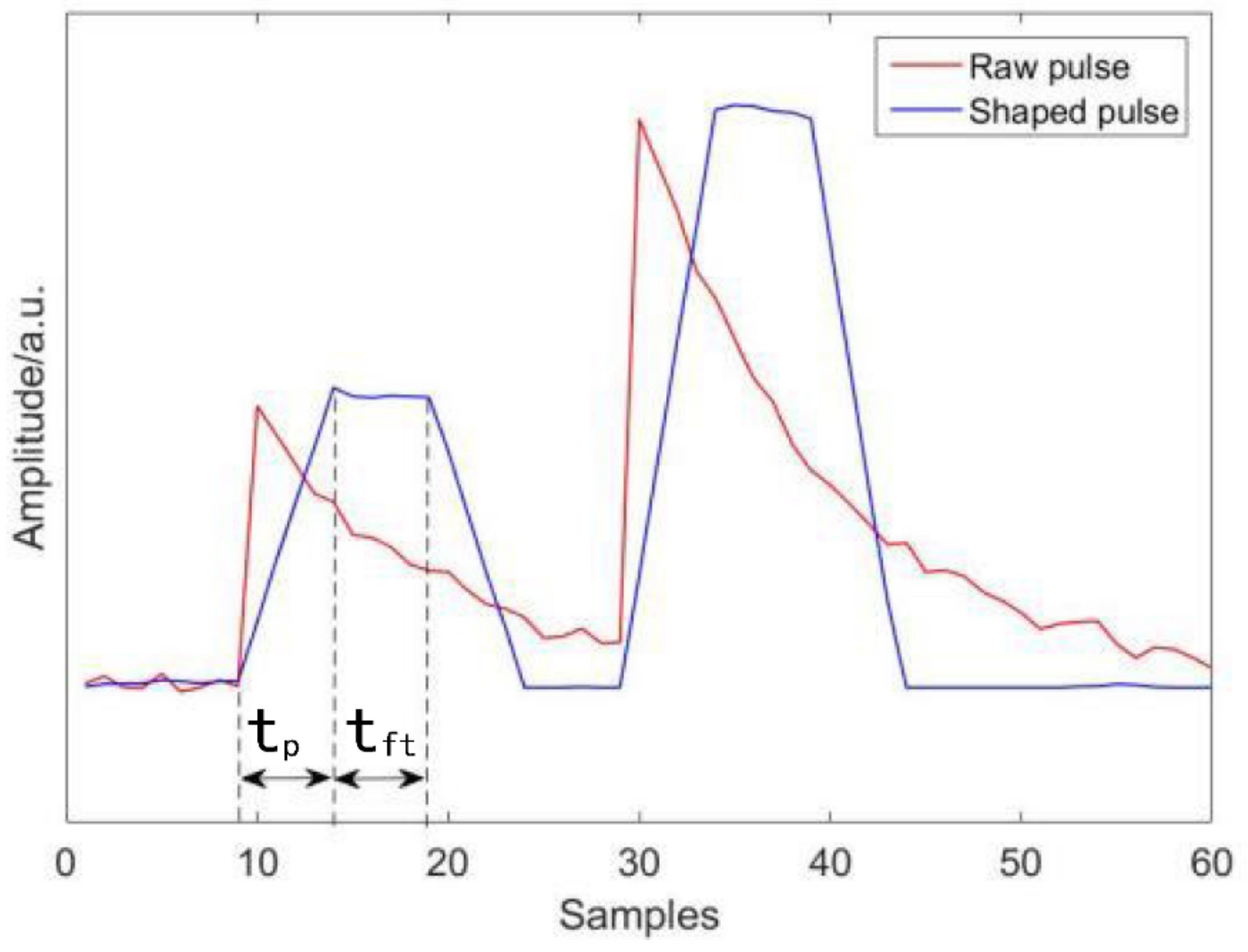
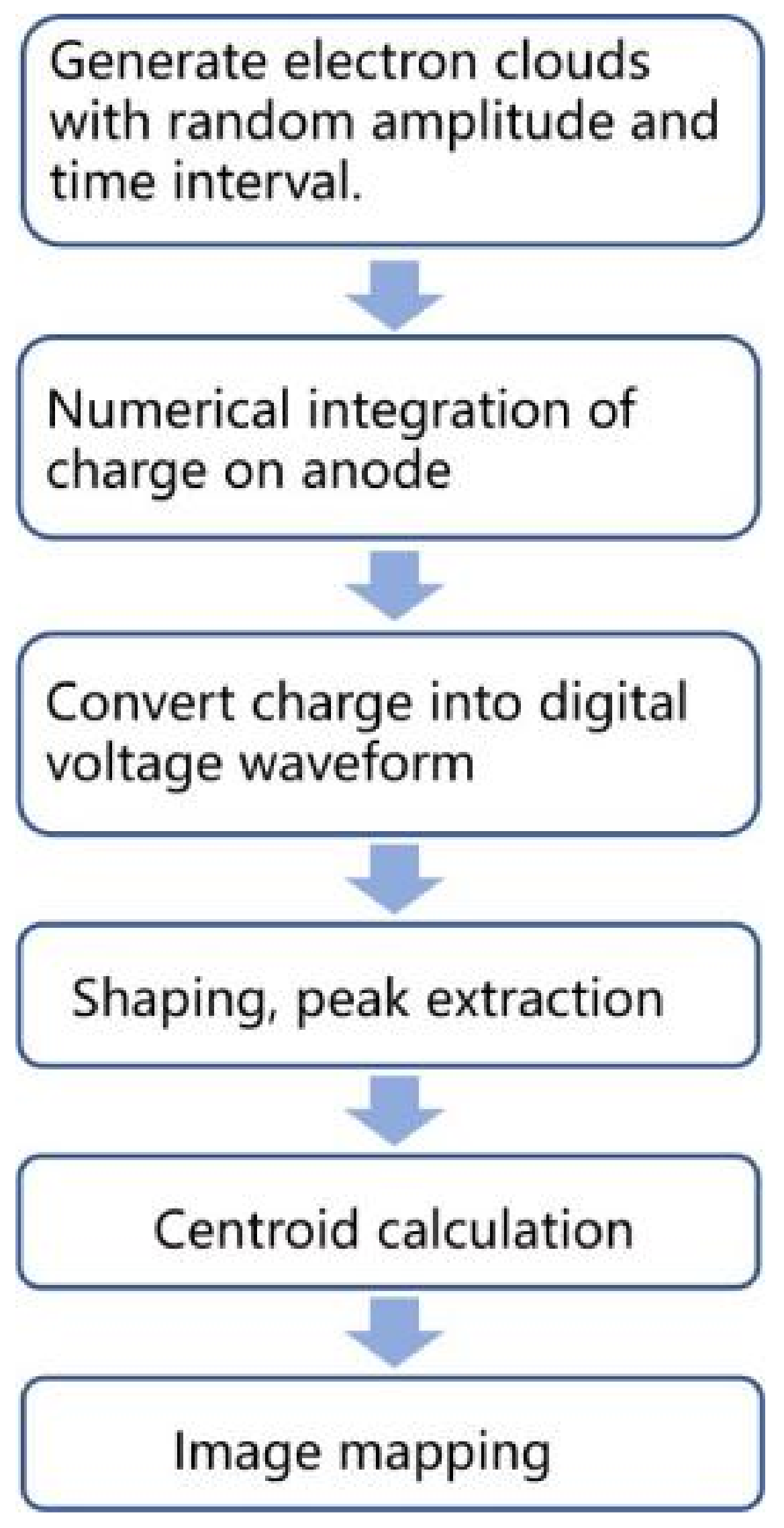
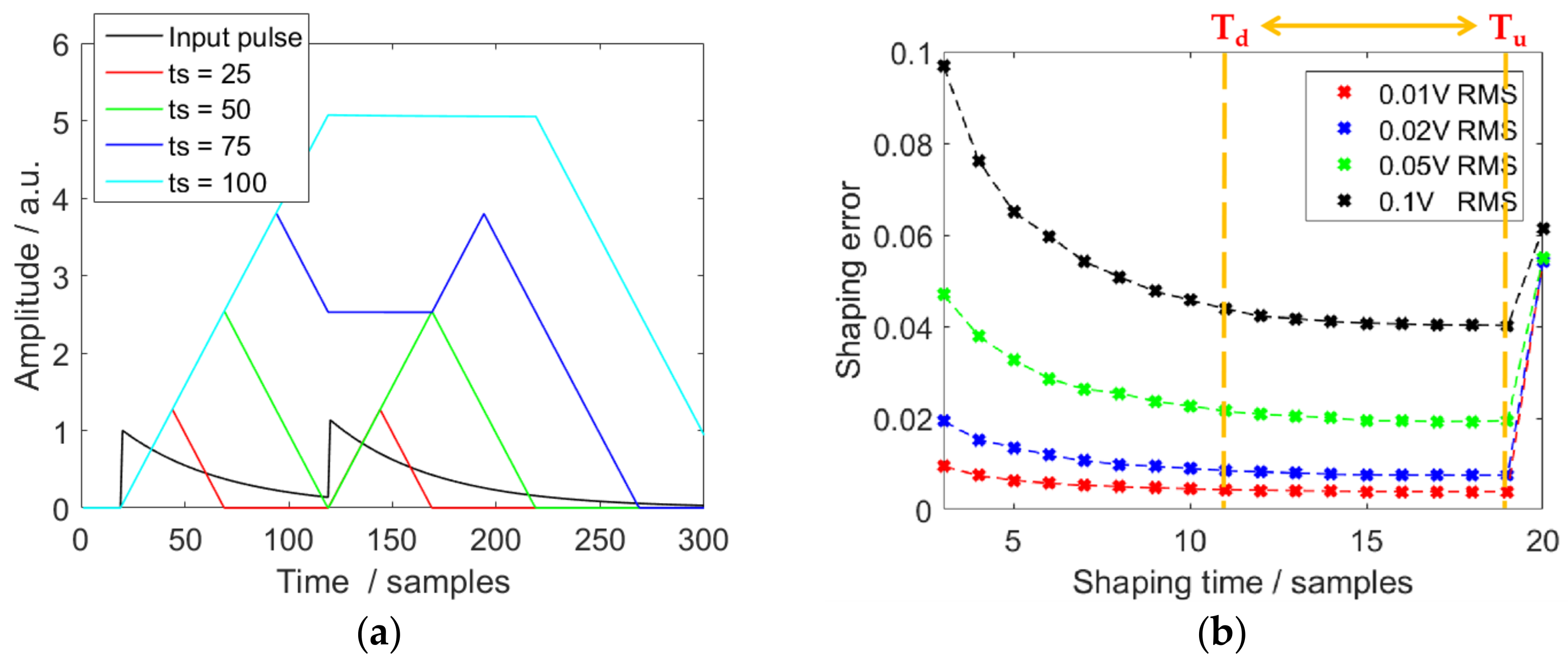

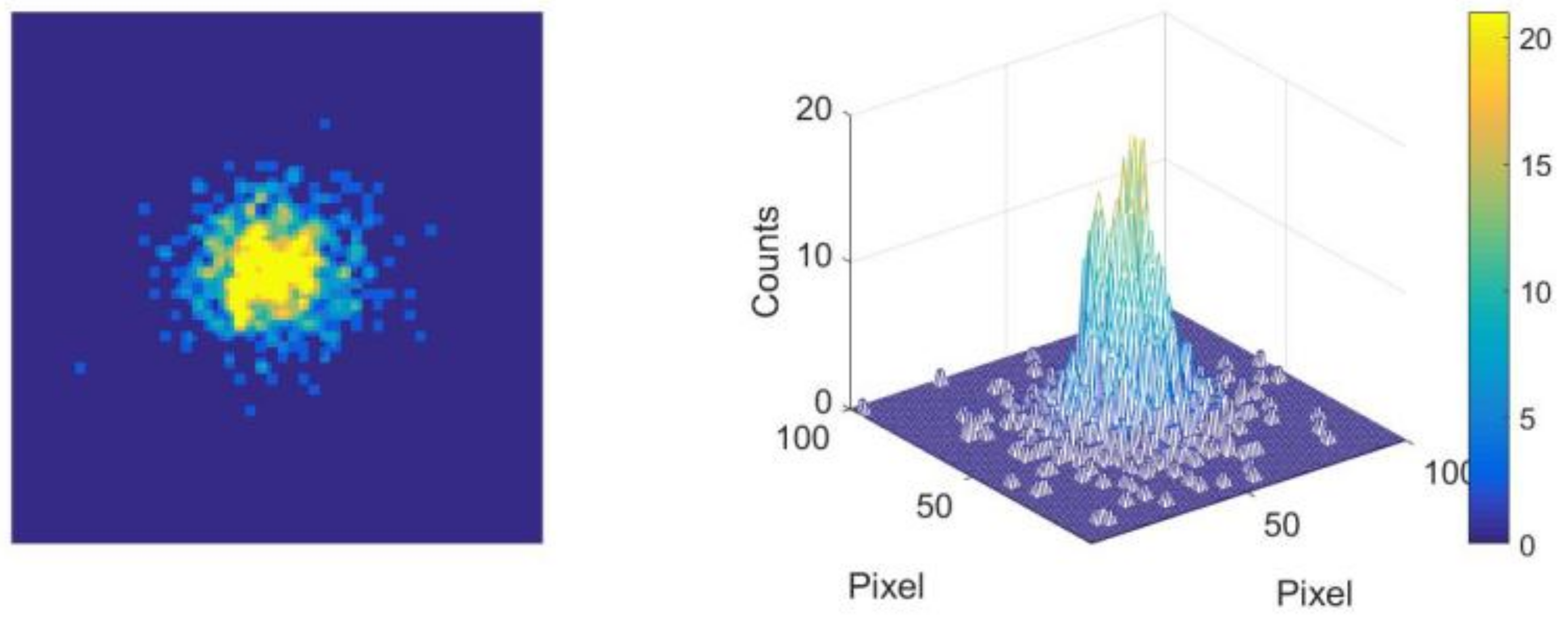

Disclaimer/Publisher’s Note: The statements, opinions and data contained in all publications are solely those of the individual author(s) and contributor(s) and not of MDPI and/or the editor(s). MDPI and/or the editor(s) disclaim responsibility for any injury to people or property resulting from any ideas, methods, instructions or products referred to in the content. |
© 2023 by the authors. Licensee MDPI, Basel, Switzerland. This article is an open access article distributed under the terms and conditions of the Creative Commons Attribution (CC BY) license (https://creativecommons.org/licenses/by/4.0/).
Share and Cite
Jiang, Z.; Ni, Q. A Photon Imaging Detector Model with High Resolution and High Counting Rate. Appl. Sci. 2023, 13, 5798. https://doi.org/10.3390/app13095798
Jiang Z, Ni Q. A Photon Imaging Detector Model with High Resolution and High Counting Rate. Applied Sciences. 2023; 13(9):5798. https://doi.org/10.3390/app13095798
Chicago/Turabian StyleJiang, Zhongzhi, and Qiliang Ni. 2023. "A Photon Imaging Detector Model with High Resolution and High Counting Rate" Applied Sciences 13, no. 9: 5798. https://doi.org/10.3390/app13095798
APA StyleJiang, Z., & Ni, Q. (2023). A Photon Imaging Detector Model with High Resolution and High Counting Rate. Applied Sciences, 13(9), 5798. https://doi.org/10.3390/app13095798





